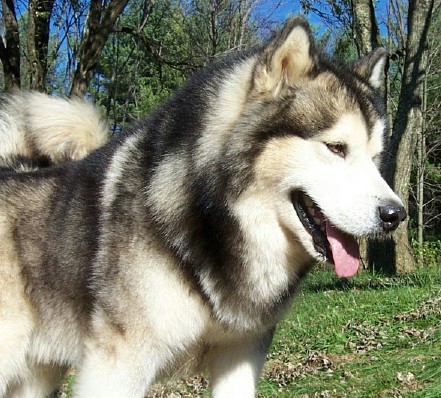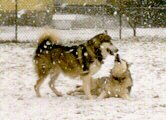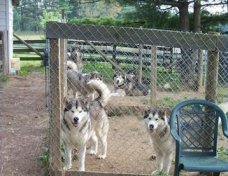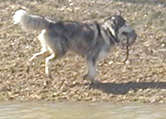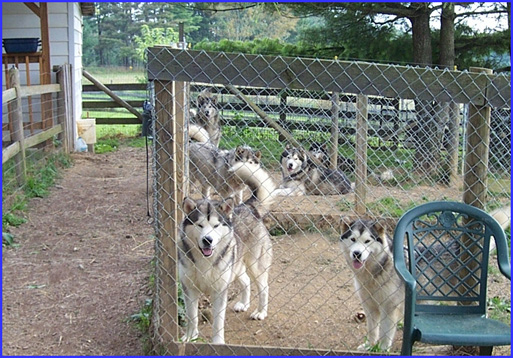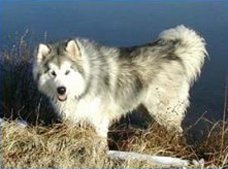
Long Coat Wooly
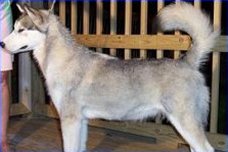
Out Of Coat

 |
Double Coated Breeds
Coats may be medium or long in length, Dense
consisting of two textures of hair, the outer
or guard coat and the soft, downy undercoat.
Double coated breeds do shed year round with
increased shedding in the Spring and in the
Fall. The two peak shedding seasons: Spring
and Fall because the change in natural light
triggers the release of undercoat as new
growth begins. Females will blow their coats
usually twice a year whereas a dog will hold
his for most of a year and if carefully handled
as he gets older for 18 months and longer.
The older dogs tend to "roll" their
coats . This means they are never really
out of coat and can last as much as two years.
Routine and thorough brushing of your dog’s
coat is the most important step in maintenance
grooming. Regular brushing reduces shedding,
prevents matting, while enhancing skin and
coat health. Remember, any hair that is loosened
and removed in the basic grooming process
is that much less hair that enters your environment!
Your double-coated dog needs more attention
than a simple surface grooming can provide.
One word of caution: Do not shave your double-coated
dog to "keep him cool for the summer."
The hair that keeps the heat in, also keeps
the heat out. It is not beneficial to the
dog in any way could have long term effects.
Dogs shed the excess, unneeded hair during
the warmer months. Use a strong cattle dryer
and blow out dead hair in the coat after
bathing every week. This allows the coat
to regenerate on a constant basis and prevents
that awful felting and clumping one tends
to see on some dogs. Looks awful as these
breeds are definitely not "wash and
wear". The weekly coat blowing also
keeps the coat even without the horrid holes
that occur when the dog is shedding. Your
dog will stay neat and tidy .
BATH TIME -
- shampoo
- conditioner
- dry towels
- blower-dryer
- grooming table
- cotton for cleaning ears & eyes
- nails cutter
- metal comb
- pin-brush, soft
- straight scissors
Begin grooming your dog at an early age and
he will become confident and easier to manage.
Collect towel, shampoo, brush, cotton wool
for ears . Fill a dish soap bottle with hand-hot
water and the shampoo. Groom the dog on a
grooming table or firm surface, covered with
a piece of non-slip rubber, such as a car
or bath mat. Brush out coat first , Use a
fine mist spray before on every layer,so
as not to break the coat . Wet the dog with
hose . Squeeze soapy water/ shampoo over
the dog, start from the rear and work forwards.
Clean eyes and ears with small towel soaked
in clean non soapy water. Towel head and
back, this is a good opportunity to feel
for lumps , Let him shake. Dry dog by using
a strong cattle dryer , cool air only. Dry
the coat forwards from the rear to the head
Don't forget to carefully comb the underneath
of the tail near the base. Comb and brush
, for the short hair areas such as ears face
and legs. Use a flea comb. It really fluffs
these out. Choosing the appropriate tools
and using them correctly will make your grooming
session more efficient, effective and enjoyable
Because of their special grooming needs,
double-coated dogs may require some extra
grooming tools to keep them looking their
very best.
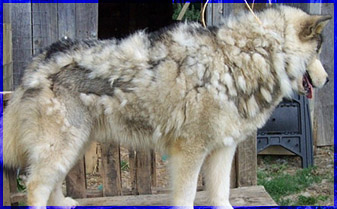
Blowing Coat ... ABOVE PHOTO, ( sheding) for the Summer. Malamutes "blow"
their undercoats, that is, they shed their
undercoats completely. It is a very intense
shedding period that can last up to three
weeks from start to finish
|


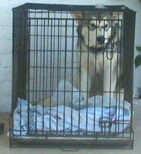

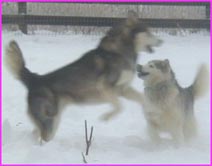

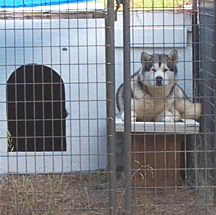
|
Training
Train your dog. Every dog should have basic
manners, but dogs are not born knowing how
to behave. Take the time to train your dog
on a consistent basis using kind, positive
methods. Find a class near you whose methods
and philosophies you like. If faced with
a behavior problem you can't solve, ask people
you trust for a recommendation of an experienced
trainer and get professional help fast. The
sooner you begin working on a problem the
sooner you will have it solved.
Understand your dog's genetic heritage. It
is important to understand what your dog
was bred to do. It is very important to remember
that Alaskan Malamutes are a working breed.
They need something to do. Putting them in
the backyard and tossing them a bone and
expecting them to be happy us a very bad
idea. They need a lot of exercise and interaction
to be happy. The exercise can come in the
form of mushing, which is of course best,
or can easily be in the form of frequent
walks, hikes, and playing. The dog makes
a wonderful hiking companion, and with a
dog pack, can carry food and water. One final
note: unless you are defending yourself or
another person, or an animal, from attack,
it is never, absolutely never, appropriate
to hit, kick, throw or otherwise manhandle
a dog. They have a very strong sense of what
is and isn't fair, and they know that
such behaviour is not fair. At best, they
will lose respect for you; at worst, one
or both of you will be injured. Owners often
forget that the behavior that prompts a dog
to run or stay close, hunt or guard, chase
and kill or herd, work with people or work
independently are all the result of generations
of carefully selected traits. Research your
breed's history, and talk to people who understand
your breed's characteristics. You may find
that Rover's tendencies, while annoying or
amusing, are precisely what makes him what
he is. You can then decide how best to work
with your dog's instincts and where you need
to concentrate training efforts. You must
stay on top of the dog and maintain control,
which is easier to do while the dog is of
manageable size than with a stubborn adult
that has been allowed to get away with undesirable
behaviors for a long time. Malamutes are
terrific dogs, but they have special needs
when it comes to training. You can meet these
needs very easily and humanely at an early
age, or you can choose to neglect them and
end up with an unmanageable, potentially
aggressive dog, who nobody will want to live
with. And because nobody will want the dog,
he or she will stand an excellent chance
of being euthanized. In order to train a
mal successfully, you must understand what
makes these magnificent animals tick. Along
with being affectionate, playful companions,
malamutes are intelligent, independent, stubborn,
energetic and dominant creatures with a very
highly developed sense of pack hierarchy.
These traits were essential for survival
in the harsh and unforgiving environment
which mals first inhabited, and they continue
to be the essence of malamute temperament.
If you cherish and respect these characteristics,
and are able to work with them in training
your pet, you will end up with a malamute
who is a pleasure to live with. If, however,
you ignore your mals’ special training needs,
or have expectations which are simply not
within a mal’s capabilities, you and your
pet will face failure. Establish rules of
the house early, and make sure that the puppy
knows that you are in charge. For example,
if you do not want the dog on the bed as
an adult, do not allow it as a puppy.At one
time or another, every owner has to deal
with problem behavior. Understanding why
your dog does what he does, and how to handle
the situation correctly can help resolve
problems quickly. Here are some basic guidelines
that apply to nearly all problem situations:
Control the dog and you control the situation. By putting
on a training collar and lead, you can control
the dog. For many dogs, their training equipment
means business, not playtime, and this can
help in a problem situation. A dog who is
on lead cannot run away or chase people or
other animals, and his owner has a chance
to help him understand what he should do
by guiding him with the leash and collar.
Be positive. Instead of saying "NO", try giving
your dog something positive that he can do
for you, such as "Sit", or "Heel".
This positive approach means you can praise
generously for his good actions, instead
of simply yelling at him. For example, a
dog who jumps up can be told to sit, and
helped if necessary, then praised for sitting.
Allow a dog to be a dog. Often, what owners consider problem behavior
is simply normal dog behavior that they find
unpleasant or annoying. For example, digging
is a natural canine activity but distressing
to a garden proud owner. Instead of scolding
for what comes naturally, it might be kinder
to set up an area in which you have buried
small treats to make it more attractive than
the rest of the yard, and praising your dog
for digging in "his" garden.
Whenever natural behaviors conflict with
what you might like, be creative and see
if you can find an outlet for those interests
and activities that is suitable for you both.
Be consistent. It is unfair to the dog to change your
rules depending on what you're wearing, who's
visiting or the kind of day you've had. If
your dog is allowed on the furniture, he
will be confused when you yell at him because
Aunt Bess is visiting and she doesn't think
dogs should sit in chairs! If he's allowed
to jump up when you're wearing jeans and
a sweatshirt, don't be surprised if he can't
tell the difference between that and your
best evening gown. Whatever your rules are,
keep them consistent.
Have your dog earn what he wants. While everyone needs a few freebies now
and then, your dog will not think you are
a wonderful owner if you play with him, walk
him, feed him and pet him whenever he demands
it. In fact, this often creates problems
since from the dog's point of view an owner
who can be "trained" this well
is not one who deserves much respect. Teach
your dog to say "please" by sitting,
laying down or following some other command
before he gets what he wants.
Be clear. Owners often confuse dogs by changing the
words or commands, repeating them over and
over again without showing the dog what is
meant, and worst of all, assuming that the
dog understands. When in doubt, gently show
your dog physically exactly what you mean,
giving the command at the same time so that
he can associate the two. Use clear, matter
of fact commands when addressing your dog,
and be sure that your praising tone is excited,
enthusiastic and upbeat. Remember that while
we use words to communicate, dogs are masters
of reading body language. If your body language
tells the dog one thing, but your voice tells
the dog something else, chances are he will
believe your body language. This is why people
who bend towards their dog and shake a finger
at them while scolding "No, no, no"
often receive a playful bark - their body
posture is much more like a dog inviting
play than a dog who is annoyed or angry.
Exercise, exercise, exercise! The most common cause of problem behavior
is boredom and a lack of sufficient exercise.
While you work or go out, your dog has little
or nothing to do, and his need to exercise
will not go away. A familiar yard or house
is boring, and few dogs exercise on their
own without interaction with their owners.
Take the time to play with your dog, jog
with him, walk in the woods, swim or take
long brisk walks each day. A tired dog is
always a well behaved dog!
Provide mental stimulation. Dr. Roger Abrante's suggestions regarding
using 1/3 of your dog's diet for treats to
be earned during training, 1/3 to be given
as usual in a food bowl, and 1/3 to be "hunted"
(try a Buster Cube, an ingenious toy which
the dog must persistently work with to receive
a few kibble at a time. Even a border collie
will be amused by this for hours! Buster
Cubes are available from your local pet store
or from DogWise.com.) This "home alone"
1/3-1/3-1/3 program helps your dog expend
some energy and provides much needed stimulation.
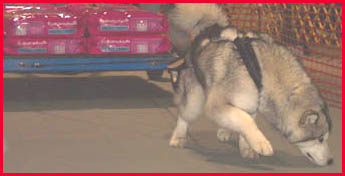
|

